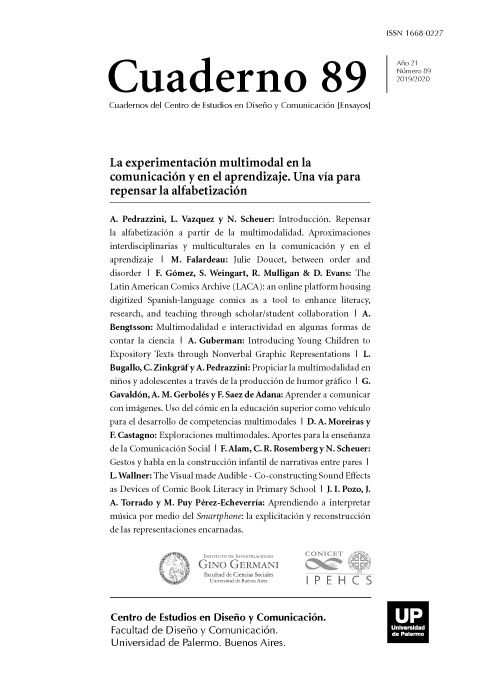Aprender a comunicar con imágenes. Uso del cómic en la educación superior como vehículo para el desarrollo de competencias multimodales
Abstract
The initial training of teachers should contemplate in their programs the development of the multimodal competencies of the future teachers since they will be the ones who will promote those competencies in their students. This research has favored the creation of knowledge about the use of comics as a tool to enhance the development of multimodal communication skills in higher education. The study was carried out through an action-research process during two academic courses with the participation of 71 students in the first year and 130 in the second one. The creation of comics by students reflects their potential to develop both critical thinking skills and multimodal literacy. However, we must clarify and take into account that the creation of comics requires understanding and knowing the visual semiotics, grammar and linguistic tools of this medium. Being a complex and new process for most students, it is advisable to plan scaffolding activities in which feedback is conceived as a fundamental factor for the achievement of learning objectives.
References
Ball, D. M., y Kuhlman, M. B. (2010). The Comics of Chris Ware : Drawing Is a Way of Thinking. University Press of Mississippi.
Berger, A. (1971). Comics and Culture. Journal Of Popular Culture, V(1), 164–178 ST–Comics and Culture.
Bezemer, J., y Kress, G. (2016). Multimodality, Learning and Communication: A Social Semiotic Frame. New York: Routledge.
Biggs, J., y Collis, K. (1989). Towards a Model of School-based Curriculum Development and Assessment Using the SOLO Taxonomy. Australian Journal of Education, 33(2), 151–163.
Brenna, B. (2013). How graphic novels support reading comprehension strategy development in children. Literacy, 47(2), 88–94.
Brockbank, A., McGill, I., y Manzano, P. (2002). Aprendizaje reflexivo en la educación superior. Madrid: Ediciones Morata.
Carano, K. T., y Clabough, J. (2016). Images of Struggle: Teaching Human Rights with Graphic Novels. The Social Studies, 107(1), 14-18.
Chute, H. (2008). Comics as Literature? Reading Graphic Narrative. Pmla, 123(2), 452–465.
Cook, M. P. (2017). Now I ‘See’: The Impact of Graphic Novels on Reading Comprehension in High School English Classrooms. Literacy Research and Instruction, 56(1), 21–53.
D’Angelo, M., y Cantoni, L. (2006). Comics: Semiotic Approaches. In Encyclopedia of Language and Linguistics (pp. 627–635).
Eckert, L. S. (2013). Protecting Pedagogical Choice: Theory, Graphic Novels, and Textual Complexity. Language Arts Journal of Michigan, 29(1), 40-43.
Frey, N., y Fisher, D. (2008). Teaching visual literacy : using comic books, graphic novels, anime, cartoons, and more to develop comprehension and thinking skills. California: Corwin Press.
Gillenwater, C. (2009). Lost Literacy: How Graphic Novels can recover Visual literacy in the Literacy Classroom. Afterimage, 37(2), 83-97.
Hajdu, D. (2008). The ten-cent plague : the great comic-book scare and how it changed America. New York: Farrar, Straus and Giroux.
Herbst, P., Chazan, D., Chen, C. L., Chieu, V. M., y Weiss, M. (2011). Using comics-based representations of teaching, and technology, to bring practice to teacher education courses. ZDM - International Journal on Mathematics Education, 43(1), 91–103.
Hill, C. (2017). Teaching comics through multiple lenses : critical perspectives. New York: Routledge.
Jacobs, D. (2007). More than Words: Comics as a Means of Teaching Multiple Literacies. English Journal, 96(3), 19-34.
Jacobs, D. (2013). Graphic encounters : comics and the sponsorship of multimodal literacy. New York: Bloomsbury.
Kress, G. (2010). Multimodality: A Social Semiotic Approach to Contemporary Communication. New York: Routledge.
Lankshear, C., y Knobel, M. (2011). New literacies. Maidenhead: Open University Press.
Lunenberg, M., Ponte, P., y Van De Ven, P.-H. (2007). Why Shouldn’t Teachers and Teacher Educators Conduct Research on their Own Practices? An Epistemological Exploration. European Educational Research Journal, 6(1), 15-29.
Mcguire, J. M., Scott, S. S., y Shaw, S. F. (2006). Universal Design and Its Applications in Educational Environments. Remedial and Special Education, 27(3), 166–175.
Meskin, A. (2009). Comics as literature? British Journal of Aesthetics, 49(3), 219- 239. Naghshineh, S., Hafler, J. P., Miller, A. R., Blanco, M. A., Lipsitz, S. R., Dubroff, R. P. y Katz,
J. T. (2008). Formal art observation training improves medical students’ visual diagnostic skills. Journal of General Internal Medicine, 23(7), 991–997.
Phelps, R., y Hase, S. (2005). Complexity and action research: exploring the theoretical and methodological connections. Educational Action Research, 10(3), 507–524.
Rappolt-Schlichtmann, G., Daley, S. G., y Rose, T. (2012). A research reader in universal design for learning. Boston: Harvard Education Press.
Rodríguez Diéguez, J. L. (1988). El cómic y su utilización didáctica : los tebeos en la enseñanza. Madrid: Tabanque.
Smith, G. M. (2011). It Ain’t Easy Studying Comics. Cinema Journal, 50(3), 110–112.
Tilley, C. L. (2008). Reading comics. School Library Media Activities Monthly, 24(5), 23–26.
Tonucci, F. (2007). FRATO 40 años con ojos de niño. Barcelona: Graó.
Wartenberg, T. E. (2012). Wordy Pictures: Theorizing the Relationship Between Image and Text in Comics. In Aaron Meskin y Roy T. Cook (eds.) The Art of Comics: A Philosophical Approach (pp. 85–104), Canada: Blackwell Publishing.
Yıldırım, A. H. (2013). Using Graphic Novels in the Classroom. Journal of Language and Literature Education, 8(2008), 118–131.
Yunus, M. M., Salehi, H., y Embi, M. A. (2012). Effects of using digital comics to improve ESL writing. Research Journal of Applied Sciences, Engineering and Technology, 4(18), 3462–3469.
Los autores/as que publiquen en esta revista ceden los derechos de autor y de publicación a "Cuadernos del Centro de Estudios de Diseño y Comunicación", Aceptando el registro de su trabajo bajo una licencia de atribución de Creative Commons, que permite a terceros utilizar lo publicado siempre que de el crédito pertinente a los autores y a esta revista.


